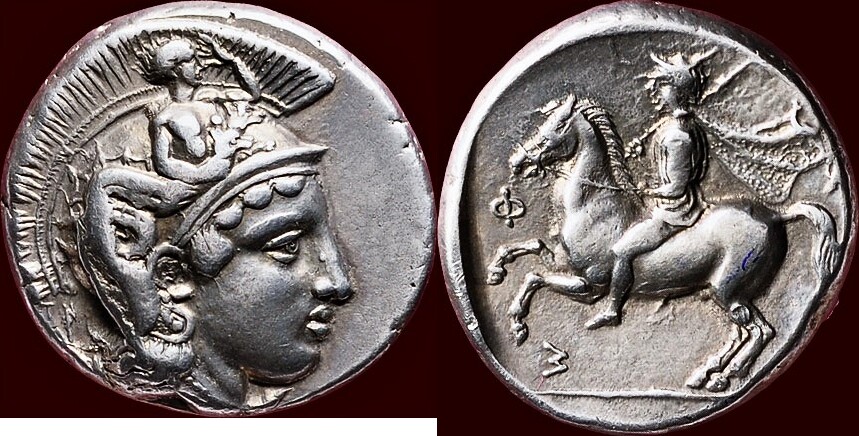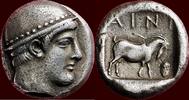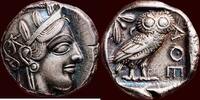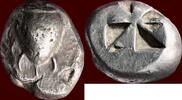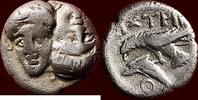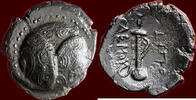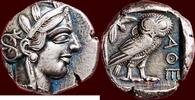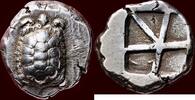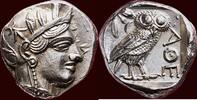MA-ID: 8099002010
Bewertungen Henzen
Schnelle Lieferung. Super Ware. Vielen Dank!
O.K.
perfekt !!!
Great coin, quick delivery, thanks!
AR Drachm 400-370 BC v. Chr. THESSALIA, PHARSALOS - SIGNED PIECE OF MASTER DIE CUTTER TELEPHANTOS AND HIS PUPIL “MI…” - circa 400-370 BC (xf with small cut SFR 10.000 +18%)
Munthandel G.Henzen 

10
Seit 10 Jahren bei MA-Shops
7244 Bewertungen,
100 % Positiv (seit 24 Monaten)
Weltweiter Versand
7500,00 EUR
Differenzbesteuert nach §25a UStG
zzgl. 18,00 EUR Versand ( nach Deutschland )
Lieferzeit: 5 - 8 Tage*
zzgl. 18,00 EUR Versand ( nach Deutschland )
| Bestellhotline +49 (0)2871 2180 383 |
| Zahlungsarten |
| Überweisung |
weight 6,07gr. | silver Ø 18mm.
Dies signed by the engraver Telephantos and his pupil “Mi…”.
obv. Head of Athena right, wearing pearl necklace and a crested Attic helmet adorned with a figure of Skylla to right, her left hand raised to shade her eyes
in tiny letters behind neck TH / MI
rev. Helmeted Thessalian cavalryman on horse prancing to left on groundline,
wearing chlamys and short chiton, holding lagobolon over his
right shoulder, Φ - A / P - Σ in field Located in Phthiotis (which was the homeland of the Myrmidons, as well as Peleus, the father of Achilles), Pharsalos was one of the major poleis of Thessaly. Continuously occupied since Neolithic times, its visible remains include a portion of a so-called Cyclopean Wall and a Mycenaean- period tomb. In the Archaic and Classical periods, Pharsalos was under the control of three major families – the Echekratidai, the Menonidai, and the Daochidai. At the time of the second invasion of Greece by the Persians (480-479 BC), the city was allied with Athens. During the so-called First Peloponnesian War (460-445 BC), the Athenians attempted to capture Pharsalos (which by then was outside of the influence of Athens), but failed, though both cities later became allies again. During the late 5th and early 4th centuries BC, Pharsalos was beset by such civil strife, that Polydamas was entrusted with supreme power over that city in 375 BC. Later, Polydamas concluded an agreement with Jason of Pherai, making Jason of Thessaly. Immediately following the assassination of of Jason in 370 BC, his successor, Polyphron, had Polydamas murdered along with eight other leading citizens of Pharsalos. For a period in the 4th century Pherai dominated the affairs of Pharsalos, but after the arrival of Philip II, the situation was reversed. Pharsalos received Halos in 346 as an outlet to the sea. In 323 BC, Pharsalos joined the revolt against Macedonia as a result the Daochids were expelled by Antipater and the city lost its independence. During the Second (200-197 BC) and Third (171-168 BC) Macedonian Wars, Thessaly (now allied with Rome and, since 189 BC, a member of the Thessalian League) became the primary battleground, and the Thessalian cavalry (composed largely of horsemen from Pharsalos) frequently battled with the Macedonians. In 48 BC, the plains to the northwest of the city were the site of the Battle of Pharsalus, the decisive victory of Julius Caesar over the Pompey and the Republic (see Lucan, Bellum Civile, 7). After then, the town, although it remained a part of the Thessalian League, diminished in importance throughout the remainder of antiquity.
A splendid coin with beautiful surfaces and lovely style from
the master die cutter Telephantos and his pupil (Mi…). Very rare. BMC - | SNG.Copenhagen - | Lavva 159 McClean -
SNG.Delepierre 1142 | Weber collection - | HGC 6, - (cf. 626)
BCD. Thessaly I, - (cf. 641) cf. BCD. Thessaly II. 1288,
withsame obverse die (xf with small cut SFR 10.000 +18%) RR
xf-
Dies signed by the engraver Telephantos and his pupil “Mi…”.
obv. Head of Athena right, wearing pearl necklace and a crested Attic helmet adorned with a figure of Skylla to right, her left hand raised to shade her eyes
in tiny letters behind neck TH / MI
rev. Helmeted Thessalian cavalryman on horse prancing to left on groundline,
wearing chlamys and short chiton, holding lagobolon over his
right shoulder, Φ - A / P - Σ in field Located in Phthiotis (which was the homeland of the Myrmidons, as well as Peleus, the father of Achilles), Pharsalos was one of the major poleis of Thessaly. Continuously occupied since Neolithic times, its visible remains include a portion of a so-called Cyclopean Wall and a Mycenaean- period tomb. In the Archaic and Classical periods, Pharsalos was under the control of three major families – the Echekratidai, the Menonidai, and the Daochidai. At the time of the second invasion of Greece by the Persians (480-479 BC), the city was allied with Athens. During the so-called First Peloponnesian War (460-445 BC), the Athenians attempted to capture Pharsalos (which by then was outside of the influence of Athens), but failed, though both cities later became allies again. During the late 5th and early 4th centuries BC, Pharsalos was beset by such civil strife, that Polydamas was entrusted with supreme power over that city in 375 BC. Later, Polydamas concluded an agreement with Jason of Pherai, making Jason of Thessaly. Immediately following the assassination of of Jason in 370 BC, his successor, Polyphron, had Polydamas murdered along with eight other leading citizens of Pharsalos. For a period in the 4th century Pherai dominated the affairs of Pharsalos, but after the arrival of Philip II, the situation was reversed. Pharsalos received Halos in 346 as an outlet to the sea. In 323 BC, Pharsalos joined the revolt against Macedonia as a result the Daochids were expelled by Antipater and the city lost its independence. During the Second (200-197 BC) and Third (171-168 BC) Macedonian Wars, Thessaly (now allied with Rome and, since 189 BC, a member of the Thessalian League) became the primary battleground, and the Thessalian cavalry (composed largely of horsemen from Pharsalos) frequently battled with the Macedonians. In 48 BC, the plains to the northwest of the city were the site of the Battle of Pharsalus, the decisive victory of Julius Caesar over the Pompey and the Republic (see Lucan, Bellum Civile, 7). After then, the town, although it remained a part of the Thessalian League, diminished in importance throughout the remainder of antiquity.
A splendid coin with beautiful surfaces and lovely style from
the master die cutter Telephantos and his pupil (Mi…). Very rare. BMC - | SNG.Copenhagen - | Lavva 159 McClean -
SNG.Delepierre 1142 | Weber collection - | HGC 6, - (cf. 626)
BCD. Thessaly I, - (cf. 641) cf. BCD. Thessaly II. 1288,
withsame obverse die (xf with small cut SFR 10.000 +18%) RR
xf-
Bitte beachten Sie unsere Mindestabnahme von 20 Euro. Sendungen nach China sind auf Gefahr des Käufers und nur Zahlung per banküberweisung. An PayPal und Kreditkarte Zahlungen sind immer Verwaltungs- und Risikokosten verbunden. Sendungen nach Russland, Ukraine und israel sind nicht möglich. Der Versand erfolgt innerhalb von 5 Tagen nach Zahlungseingang. BITTE KEIN PAYPAL ODER KREDITKARTE ZAHLUNGEN FÜR EU. Zahlen Sie bitte immer nur mit IBAN; schnell, billig und zuverlässich.
| Versandkosten | ||||
|---|---|---|---|---|
| bis 100,00 EUR | 100,00 EUR bis 500,00 EUR | 500,00 EUR bis 1000,00 EUR | über 1000,00 EUR | |
| Argentinien | 32,00 EUR | 32,00 EUR | 40,00 EUR | 40,00 EUR |
| Australien | 35,00 EUR | 35,00 EUR | 40,00 EUR | 40,00 EUR |
| Belgien | 9,50 EUR | 11,00 EUR | 13,00 EUR | 18,00 EUR |
| Brasilien | 55,00 EUR | 55,00 EUR | 55,00 EUR | 55,00 EUR |
| Bulgarien | 14,00 EUR | 16,00 EUR | 35,00 EUR | 45,00 EUR |
| Chile | 50,00 EUR | 50,00 EUR | 50,00 EUR | 50,00 EUR |
| China | 40,00 EUR | 40,00 EUR | 50,00 EUR | 50,00 EUR |
| Dänemark | 11,50 EUR | 13,00 EUR | 16,00 EUR | 20,00 EUR |
| Deutschland | 9,50 EUR | 11,00 EUR | 13,00 EUR | 18,00 EUR |
| Estland | 13,00 EUR | 14,00 EUR | 15,00 EUR | 25,00 EUR |
| Frankreich | 9,50 EUR | 11,00 EUR | 16,00 EUR | 25,00 EUR |
| Griechenland | 15,00 EUR | 25,00 EUR | 30,00 EUR | 35,00 EUR |
| Großbritannien | 25,00 EUR | 25,00 EUR | 26,00 EUR | 28,00 EUR |
| Hong Kong | 40,00 EUR | 40,00 EUR | 50,00 EUR | 50,00 EUR |
| Indien | 35,00 EUR | 35,00 EUR | 40,00 EUR | 50,00 EUR |
| Indonesien | 35,00 EUR | 35,00 EUR | 40,00 EUR | 40,00 EUR |
| Israel | 200,00 EUR | 200,00 EUR | 200,00 EUR | 200,00 EUR |
| Japan | 40,00 EUR | 40,00 EUR | 40,00 EUR | 40,00 EUR |
| Kambodscha | 65,00 EUR | 65,00 EUR | 65,00 EUR | 65,00 EUR |
| Kanada | 30,00 EUR | 30,00 EUR | 35,00 EUR | 35,00 EUR |
| Liechtenstein | 20,00 EUR | 20,00 EUR | 25,00 EUR | 25,00 EUR |
| Luxemburg | 11,00 EUR | 13,00 EUR | 16,00 EUR | 25,00 EUR |
| Malaysia | 35,00 EUR | 35,00 EUR | 40,00 EUR | 45,00 EUR |
| Niederlande | 8,50 EUR | 8,50 EUR | 11,00 EUR | 14,00 EUR |
| Norwegen | 25,00 EUR | 25,00 EUR | 30,00 EUR | 35,00 EUR |
| Österreich | 11,50 EUR | 12,50 EUR | 15,00 EUR | 25,00 EUR |
| Polen | 13,00 EUR | 14,00 EUR | 16,50 EUR | 25,00 EUR |
| Portugal | 13,00 EUR | 14,00 EUR | 18,00 EUR | 25,00 EUR |
| Rumänien | 16,00 EUR | 18,00 EUR | 25,00 EUR | 35,00 EUR |
| Russische Föderation | 200,00 EUR | 200,00 EUR | 200,00 EUR | 200,00 EUR |
| Schweiz | 30,00 EUR | 30,00 EUR | 40,00 EUR | 40,00 EUR |
| Serbien | 25,00 EUR | 25,00 EUR | 30,00 EUR | 35,00 EUR |
| Singapur | 35,00 EUR | 35,00 EUR | 35,00 EUR | 40,00 EUR |
| Slowakei | 13,00 EUR | 15,00 EUR | 20,00 EUR | 25,00 EUR |
| Spanien | 11,50 EUR | 13,50 EUR | 16,50 EUR | 25,00 EUR |
| Sri Lanka | 35,00 EUR | 35,00 EUR | 40,00 EUR | 45,00 EUR |
| Tschechische Republik | 12,00 EUR | 14,00 EUR | 18,00 EUR | 25,00 EUR |
| Ukraine | 200,00 EUR | 200,00 EUR | 200,00 EUR | 200,00 EUR |
| Ungarn | 14,00 EUR | 16,00 EUR | 25,00 EUR | 30,00 EUR |
| Vereinigte Staaten von Amerika | 32,00 EUR | 32,00 EUR | 35,00 EUR | 40,00 EUR |
| Europäische Union | 15,00 EUR | 17,00 EUR | 25,00 EUR | 30,00 EUR |
| Welt | 40,00 EUR | 40,00 EUR | 50,00 EUR | 50,00 EUR |
Informationen zum Kauf bei MA-Shops
Bestellungen bei MA-Shops sind jederzeit möglich und werden innerhalb von 2-4 Arbeitstagen verschickt.
Ein über die MA-Shops abgesicherter Kauf findet niemals außerhalb von MA-Shops statt.
Bestellen Sie sicher online mit dem MA-Shops Warenkorb.
Vielen Dank.
Ein über die MA-Shops abgesicherter Kauf findet niemals außerhalb von MA-Shops statt.
Bestellen Sie sicher online mit dem MA-Shops Warenkorb.
Vielen Dank.
|
Verkäufer-Startseite | 0Warenkorb | AGB | Impressum | MA AGB | Datenschutzerklärung | Garantie | MA-Shops Neuzugänge Copyright ® 2001-2025, MA-SHOPS Muenzen All Rights Reserved. Designated trademarks and brands are the property of their respective owners. |
 Münzen beim Fachhändler kaufen
Münzen beim Fachhändler kaufen


